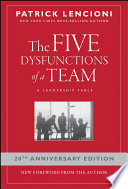

The foundation of any successful team is trust. Without trust, team members are unwilling to be vulnerable and open with one another. This lack of openness leads to a culture of fear, where individuals are reluctant to share ideas, admit mistakes, or ask for help. Trust is built through shared experiences, open communication, and the willingness to be vulnerable. In a team setting, trust allows for constructive conflict, where members can challenge each other's ideas without fear of reprisal. The absence of trust creates a toxic environment that stifles collaboration and innovation.
Continue readingHealthy conflict is essential for a team to thrive. When team members fear conflict, they tend to avoid difficult conversations and suppress differing opinions. This avoidance leads to a lack of creativity and suboptimal decision-making. Teams that embrace conflict can engage in productive debates that lead to better solutions. The key is to create a safe environment where team members feel comfortable expressing their views and challenging each other's ideas. This constructive conflict fosters a culture of collaboration and leads to stronger outcomes.
Continue readingWhen team members do not feel heard or valued during discussions, they may struggle to commit to team decisions. A lack of commitment can lead to ambiguity and uncertainty about team goals and priorities. To foster commitment, it is crucial for leaders to ensure that all voices are heard and that decisions are made collaboratively. When team members feel they have contributed to the decision-making process, they are more likely to be committed to the outcomes. This commitment is vital for achieving team objectives and maintaining accountability.
Continue readingAccountability is essential for a team's success. When team members are not held accountable for their actions, it can lead to a decline in performance and a lack of ownership over tasks. To foster accountability, teams need to establish clear expectations and standards for performance. Leaders should encourage team members to hold each other accountable in a supportive manner. This mutual accountability creates a culture where everyone is responsible for the team's success and encourages individuals to strive for excellence.
Continue readingWhen team members prioritize personal goals or departmental objectives over the team's overall success, it can lead to a lack of focus on collective results. This inattention to results undermines team performance and can create a sense of competition rather than collaboration. To combat this, teams must establish a shared vision and set clear, measurable goals. Leaders should regularly communicate the importance of team results and celebrate collective achievements. Focusing on results fosters a sense of unity and drives higher performance.
Continue readingUnderstanding team dynamics is crucial for addressing the dysfunctions that arise within a team. The interactions and relationships among team members significantly impact performance and collaboration. By recognizing the influence of team dynamics, leaders can implement strategies to build trust, encourage healthy conflict, and promote accountability. This awareness allows teams to identify and address dysfunctions proactively, creating a more cohesive and effective unit.
Continue readingLeaders play a pivotal role in addressing the five dysfunctions of a team. They must model the behaviors they wish to see in their team members and create an environment that fosters trust, open communication, and accountability. Leaders should actively seek feedback from their teams and be willing to adapt their leadership style to meet the needs of the group. By being transparent and approachable, leaders can help dismantle barriers to collaboration and create a culture of high performance.
Continue reading